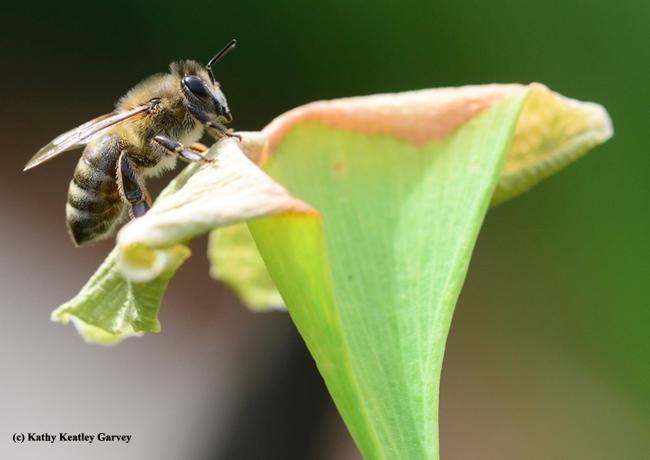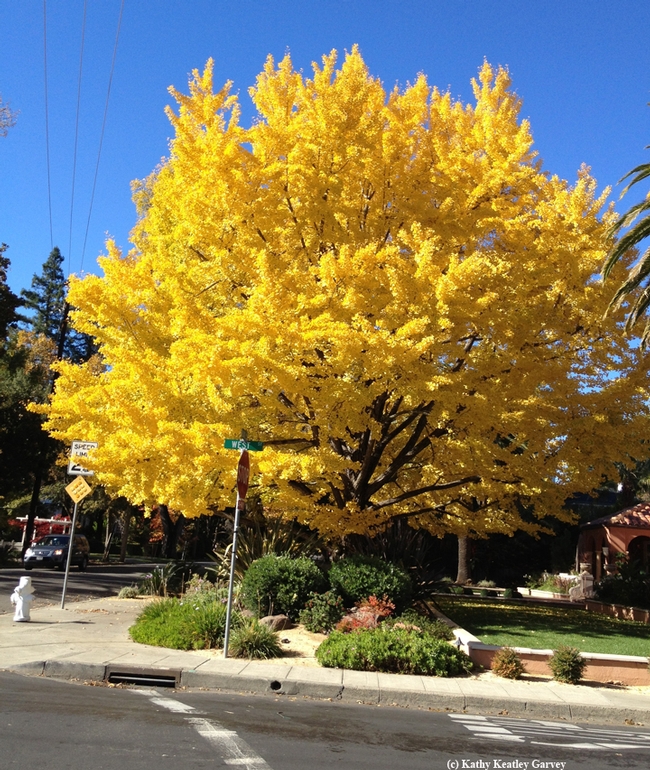I've always liked the ginkgo tree, despite the fact that honey bees don't like it. It's a non-flowering plant so there's no reward for the bees. In other words, a bee has no reason to visit it. No reason at all.
But one day a bee touched down--and lingered--on our ginkgo tree in our back yard, amid the lavender, catmint, salvia, lantana, blanket flowers, alyssum, foxgloves, gaura and tower of jewels.
Why? I don't know. But more about that later.
The ginkgo, the oldest tree species on earth, is considered “a living fossil.” It existed an estimated 250 to 285 million years ago, at a time when dinosaurs roamed the earth and before flowering plants and bees made their debut.
The ginkgo tree is tough, stubborn and resilient. It's a survivor.
Renowned botanist Peter Crane, dean of the Yale School of Forestry and Environmental Studies, wrote extensively about this unique species in his book, Ginkgo: The Tree That Time Forgot (2013, Yale University Press). He considers his book "a biography of the oldest tree on earth."
In a May 2013 interview with Environment 360 (e360), a publication of the Yale School of Forest and Environmental Studies, Crane traces the history of the ancient ginkgo back to the dinosaur age, to its cultivation in China 1000 years ago, and finally, to its presence today on city streets throughout the world.
The ginkgo “really puts our own species — let alone our individual existence — into a broader context,” Crane told Environment 360.
An excerpt from the interview:
e360: You've mentioned that ginkgo is something of a biological oddity in that it's a single species with no living relatives. That's somewhat unusual in the plant and animal world, isn't it?
Crane: Yes. When we think about flowering plants, there are about 350,000 living species. And in an evolutionary sense, they're equivalent to that one species of ginkgo. They're all more closely related to each other than they are to anything else. But the ginkgo is solitary and unique, not very obviously related to any living plant. One of the points I wanted to draw out in the book is that in the past there were a variety of ginkgo-like plants, but this is the only one surviving.
Gingko enthusiasts know that there are both male and female trees, and that city planners prefer to plant males on their city streets. Why? Because, as Crane puts it, the females “stink.” Their seeds, he says, "smell like vomit."
But back to the honey bee that landed on the ginkgo tree in our yard.
I had just finished reading former publisher Richard Rico's Sunday column, At Ease, in The Reporter, Vacaville. “About two weeks before our Kathy — Kathy Thomas Rico — passed away, family members paid a visit," he wrote. "One said he wanted to plant something in her honor. Kathy was an ardent Master Gardener. He asked if she had a preference. Without hesitation, she said, ‘Ginkgo tree.'”
So, at her celebration of life in the Buck Estate Gardens, the family handed out gingko seeds.
Kathy Thomas-Rico, who died at age 54 of cancer, was a wife, mother, retired journalist, a friend and part of the UC Agriculture and Natural Resources (UC ANR) family. She was a talented UC Master Gardener who contributed to the UC ANR blog, Under the Solano Sun.
And she loved ginkgo trees, particularly a beautiful specimen at the corner of West Street and Buck Avenue, Vacaville, on the same block as the Buck Mansion and Estate Gardens. When autumn turns its leaves a golden yellow, the tree absolutely glows. Kathy—or “Flash” as her fellow journalists nicknamed her for her propensity to complete projects rapidly--absolutely loved it.
In November of 2011, Kathy blogged about the tree in Under the Solano Sun: “You really ought to see what I think is the best example of fall beauty in all of Solano County. On the corner of Buck Avenue and West Street, in front of what is still called the old Hartley house, is an absolutely stunning Ginkgo biloba tree. I'm not sure of its age, but considering its size and how slow growing these trees are, it must be close to a century old. This tree literally stops traffic when it goes gold, which should be right about now.”
After reading the newspaper column about her memorial service and the ginkgo seeds, I stepped into our back yard to check on our own ginkgo tree, now about three feet tall. Suddenly a honey bee—the favorite insect of UC Master Gardeners--appeared as if on command.
Coincidence? Probably. But I like to think this was the work of an angel--a wife, mother, journalist, friend and a UC Master Gardener whom we all admired.
In remembrance:
Kathy Thomas-Rico, Jan. 20, 1969-April 16, 2014
Obituary
Attached Images:

